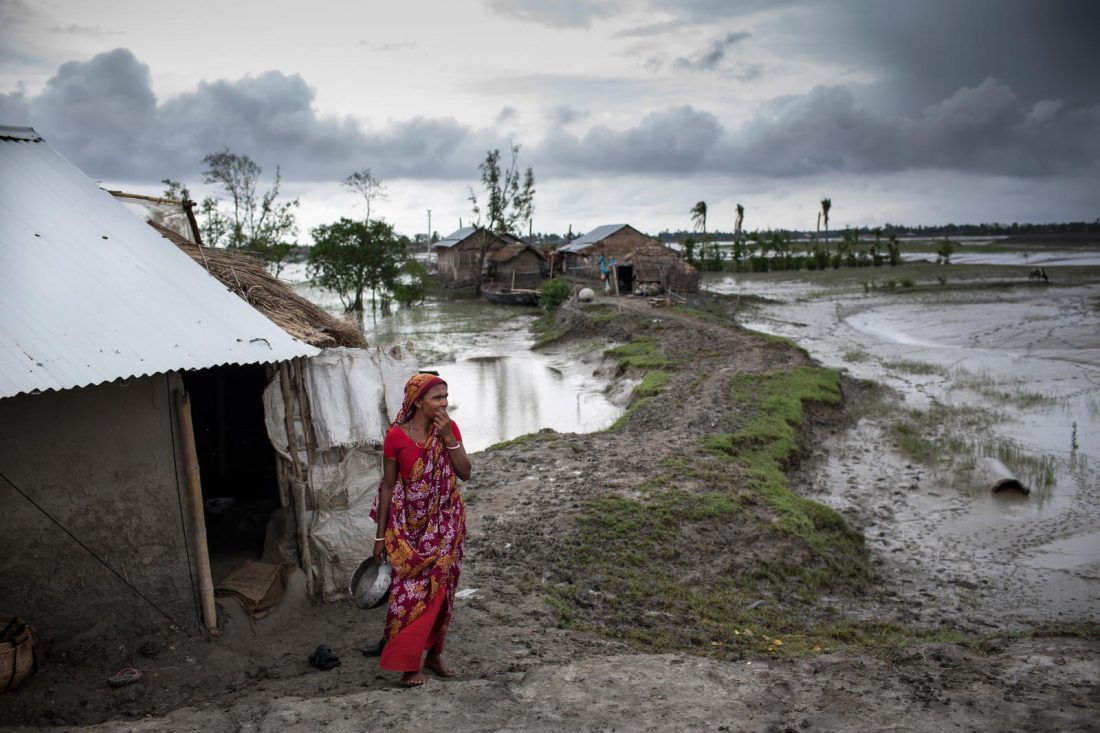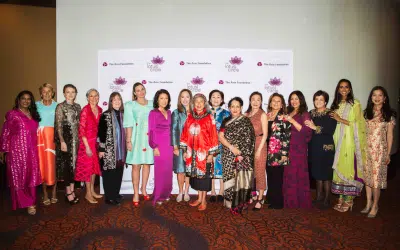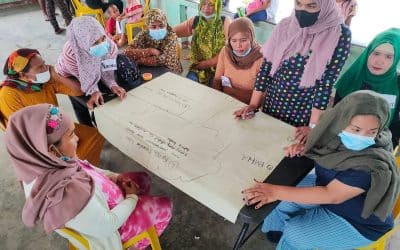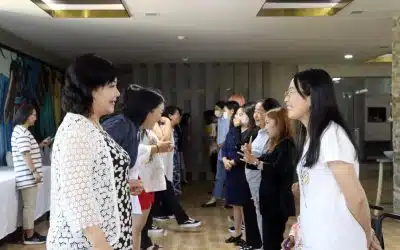InAsia
Insights and Analysis
The Gender Dimensions of a Changing Climate
September 25, 2019
The biennial conference of the Women’s Funding Network, which took place in San Francisco September 11–13, provided an opportunity for The Asia Foundation to convene the panel “Gender and Climate Justice: Lessons from Asia and the Pacific.” The changing climate is arguably the biggest issue of our time, and the follow-on effects of environmental disasters and forced migration are colliding with other trends, including aging and shrinking populations, accelerating urbanization, and health crises fueled by population growth and pollution.
The gender implications of these trends are significant. For every man and boy who died in the 2004 Asian tsunami, up to four women and girls died, largely for cultural reasons such as that they didn’t know how to swim, or they felt they were inappropriately dressed to leave their home or didn’t have their husband’s permission. Of the 190,000 people who perished in the 1991 cyclone and flood in Bangladesh, 90 percent were women and girls, in part because community warning systems were male to male, transmitted to men in public spaces where women were excluded. Adding to this, again for cultural reasons, most Bengali women never learn to swim, increasing the peril of floods.

Photo: Conor Ashleigh / The Asia Foundation
The Asia Foundation has been working with local women in two flood-prone regions along the India-Bangladesh border to build flood-warning networks in their communities. Currently, government flood warnings in the region are not location specific and can be difficult for communities to interpret. This makes it hard to respond quickly when floodwaters threaten, increasing flood damage and risking people’s lives. The Women for Climate Change Adaptation project (W4CCA), funded by The Asia Foundation’s Lotus Circle, trains women to develop local flood-response plans and to work with local institutions to improve emergency decision-making and resilience.
The W4CCA networks use local data to establish village-specific flood thresholds in project locations. When these thresholds are breached, text messages alert designated W4CCA leaders, who alert members of the flood-response team in the community and in the broader W4CCA network. Women who take on this important safety role become leaders in their villages even as they help to protect them from floods. These leadership roles have repercussions in family and community life, helping women to assume more decision-making power in the household and to gain the confidence to stand for political office.

Catastrophic flooding in Thailand, 2011. Photo: Arpaporn Winijkulchai / The Asia Foundation
In the Marwar region of Rajasthan, India, the Jal Bhagirathi Foundation (JBF) has been implementing rainwater harvesting techniques that bolster the sustainability, health, and food security of desert communities. This work reduces the burden on women, who have often had to walk three to four miles each day, in scorching heat, to collect safe drinking water. It also saves communities the burdensome cost of purchasing water for essential needs, contributing to poverty reduction.
Among the more effective techniques are sand dams, which trap seasonal runoff and restore it to the water table. These dams still allow the streams to flow, but more slowly. Sand settles behind the dam, where it becomes saturated with water that percolates into the water table. The sand also acts as a filter to produce clean drinking water. Each year, as more sand settles, more water is held by the deposits. Villages that have constructed sand dams have been able to recharge wells and grow crops such as cumin, green chilis, and mustard for local markets. The extra income helps keep families healthy and their children in school.
This work is reviving inexpensive, traditional technology to address the drinking water needs of drought-stricken populations. This includes community-led water-management systems to tap runoff from catchment areas, and underground rainwater tanks near the village. Women are encouraged to be part of the water-management group and to play an active role in the maintenance of these water-governance systems. The Asia Foundation was the first funder of this work, some 15 years ago, recognizing the critical importance of food, water, and energy security to these rural and desert communities, where summer temperatures regularly spike to 50 degrees Celsius.
Elsewhere in the Asia-Pacific, women in Fiji are constructing cyclone-resistant homes as part of a Habitat for Humanity project. In the Carteret Islands, near Papua New Guinea, women are actively involved in obtaining new land and livelihoods in Bougainville and arranging the relocation of their whole community as sea-level rise threatens their island. In Nepal, women’s groups came together after the 2015 earthquake to offer help to the most vulnerable and isolated people, including protection from violence and trafficking. And in several countries in Asia and the Pacific, grandmothers are being trained as solar engineers, making them the green wizards in their community.

Photo: Conor Ashleigh / The Asia Foundation
Because traditional gender roles place women at the front lines of climate change, they are essential as strategists and solution builders, yet very little money goes to grassroots women’s groups and movements. Despite the disparate impact of climate change on men and women, many governments’ climate-change policies are gender blind, and even when there are gender-inclusive policies, the lack of gender budgeting often leaves them starved for funds.
Here, then, are 10 ways to improve women’s climate resilience:

Photo: The Estée Lauder Companies Inc. / Michael Kistler Photography
- Invest in girls’ education, one of the most effective ways to address the gendered impacts of climate change.
- Support gender-inclusive climate policies.
- Promote gender budgeting for climate-change and disaster-risk management that reflects the specific needs of men and women.
- Provide women with equitable access to training programs to ensure their access to green jobs.
- Ensure climate financing mechanisms are flexible enough to reflect women’s priorities and needs.
- Governments must collect sex-disaggregated data and carrying out systematic gender analysis to incorporate gender perspectives into national policies for sustainable development and climate change.
- Governments should pilot pro-women green-procurement policies, given that most procurement opportunities in Asia go to businesses run by men.
- After disaster strikes, women must have opportunities to earn rather than just volunteer. Women’s knowledge and experience have much to contribute to disaster response and post-disaster reconstruction.
- Promote the creation of institutions such as green banks that provide low-interest, long-term loans to women for green enterprises like construction, waste management, and food production. The private sector can play a role by developing programs and policies throughout their value chains that place women at the center of climate-change solutions.
- Support green STEM education for young women. While women now make up the majority of STEM graduates, the preponderance of jobs in green urban design, green construction, and green waste management still go to men due to social norms and traditional beliefs about men’s ability in these fields.

Girls on their way to school, Muang Khong, Laos. Photo: Ian Taylor
Jane Sloane is senior director of The Asia Foundation’s Women’s Empowerment Program. She can be reached at [email protected]. The views and opinions expressed here are those of the author, not those of The Asia Foundation.
About our blog, InAsia
InAsia is posted and distributed every other Wednesday evening, Pacific Time. If you have any questions, please send an email to [email protected].
Contact
For questions about InAsia, or for our cross-post and re-use policy, please send an email to [email protected].The Asia Foundation
465 California St., 9th Floor
San Francisco, CA 94104
The Latest Across Asia
News
April 25, 2024
Program Snapshot
April 18, 2024
News
April 17, 2024

2024 Lotus Leadership Awards
The Lotus Leadership Awards recognize contributions towards gender equality in Asia and the Pacific







0 Comments